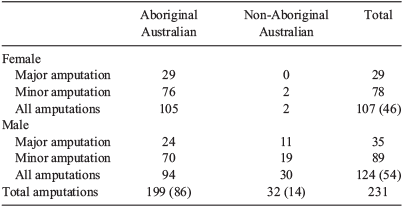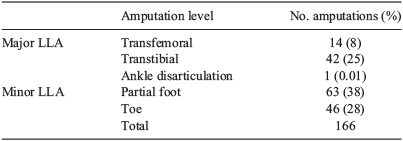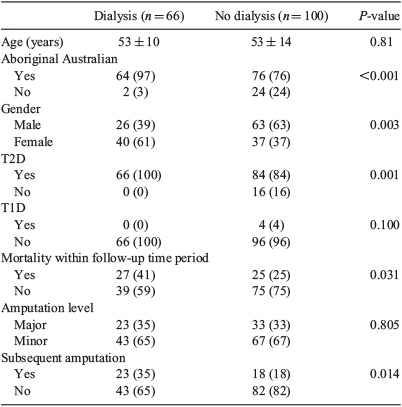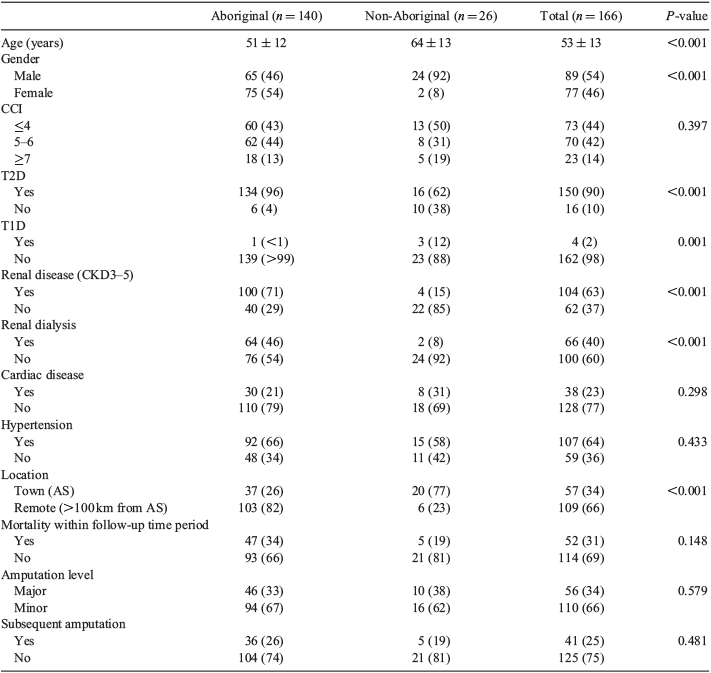Incidence of lower limb amputation in Central Australia
Laura Stuart A E , Lara Kimmel B C and Andrew Jolly DA Physiotherapy Department, Alice Springs Hospital, 6 Gap Road, Alice Springs, NT 0870, Australia.
B Physiotherapy Department, Alfred Hospital, 55 Commercial Road, Prahran, Vic. 3004, Australia. Email: l.kimmel@alfred.org.au
C Department of Epidemiology and Preventive Medicine, Monash University, Melbourne, Vic. 3800, Australia.
D Prosthetics/Orthotics Department, Alice Springs Hospital, 6 Gap Road, Alice Springs, NT 0870, Australia. Email: andrew.jolly@nt.gov.au
E Corresponding author. Email: laura.stuart@nt.gov.au
Australian Health Review 45(3) 361-367 https://doi.org/10.1071/AH20182
Submitted: 19 July 2020 Accepted: 15 August 2020 Published: 2 March 2021
Journal Compilation © AHHA 2021 Open Access CC BY-NC-ND
Abstract
Objective The aims of this study were to review the demographic details of those who have undergone lower limb amputation (LLA) surgery in Central Australia and determine the region-specific age-adjusted incidence rate of LLA.
Methods A retrospective audit of service users who underwent LLA in a Central Australian hospital from 2012 to 2017 was undertaken. Demographic, operative and postoperative outcomes data were collected. The age-adjusted incidence rate of LLA was determined using the direct method. Demographic data were analysed using descriptive parametric analysis.
Results In the period 2012–17, 166 service users underwent a total of 291 amputations in 231 episodes of care (hospital admissions). The age-adjusted incidence rate of LLA was 87.4 per 100 000 for females and 104.6 per 100 000 for males in this region. In total, 84% (n = 140) of those requiring amputation surgery identified as Aboriginal Australians (P < 0.001), 54% (n = 75) of whom were female. Aboriginal Australians who underwent LLA were, on average, 13 years younger and were more likely to have type 2 diabetes (P < 0.001) and require renal dialysis (P < 0.001) than the non-Aboriginal Australian cohort. Of the Aboriginal Australians who underwent LLA, 82% (n = 103) lived very remotely (>100 km from the central town’s centre), compared with 23% of non-Aboriginal Australians (P < 0.001). In addition, 46% (n = 64) of Aboriginal Australians who underwent LLA required renal dialysis. Those requiring renal dialysis were more likely to require subsequent amputation (P = 0.014) and had a higher mortality rate following amputation (P = 0.031). Partial foot amputation was the most common level of amputation in Central Australia (38%).
Conclusions Central Australia appears to have the highest incidence rate of LLA for any region in Australia, with Aboriginal Australians, particularly females and those undergoing renal dialysis, being disproportionately represented. Further studies should aim to determine targeted, culturally safe and successful methods of diabetic foot ulcer prevention, early detection and management with a view to reducing the high amputation rates for these cohorts.
What is known about the topic? Large health inequalities between Aboriginal and non-Aboriginal Australians exist. Aboriginal Australians are currently fourfold as likely as non-Aboriginal Australians to have type 2 diabetes (T2D), increasing their risk of LLA. There is a geographical variance in the incidence of LLA in Australia; the Northern Territory is overrepresented, with rates two- to threefold higher than that of the national average. Regional incidence rates are not currently known.
What does this paper add? This study showed that the age-adjusted incidence rate for LLA in Central Australia is significantly higher than in other regions in Australia. Most LLA surgeries undertaken in Central Australia were performed for Aboriginal Australians who have T2D, with a disproportionate representation of females and those requiring renal dialysis.
What are the implications for practitioners? This study shows that there is a need for further research and preventative measures to address the high rates of LLA among Aboriginal Australians, particularly for females and those with renal impairment. These groups could benefit from targeted, culturally safe approaches to early identification, referral and management of lower limb ulceration by relevant service providers.
Introduction
Throughout this article, Aboriginal and/or Torres Strait Islander peoples will be referred to as Aboriginal Australians. Members of the Australian population who do not identify as Aboriginal and/or Torres Strait Islander peoples will be referred to as non-Aboriginal Australians, in accordance with current recommendations.1
There is a geographical variance in the incidence of lower limb amputation (LLA) in Australia. The incidence of LLA is two- to threefold higher in the Northern Territory (NT) than in other states.2 Researchers have suggested variances in the incidence of LLA may be based on age, gender, remoteness, diabetes and socioeconomic and Aboriginal status.2,3 To date, there has been no research into the regional variation of LLA incidence in the NT.
Central Australia is the arid interior of Australia, encompassing the central town of Alice Springs, remote communities, Indigenous Protected Areas and pastoral stations across 1 million square kilometres of the NT, as well as nearby communities in the Anangu Pitjantjatjara Yankunytjatjara (APY) Lands, South Australia (SA). In the NT, 25.5% of the population identify as Aboriginal Australians.4 A high proportion of the Central Australia population, particularly those living in very remote areas, are Aboriginal Australians.
Regrettably, large health inequalities exist between Aboriginal and non-Aboriginal Australians. Aboriginal Australians are more likely to have type 2 diabetes (T2D) than non-Aboriginal Australians,5 and T2D is the second leading cause of death for this population.6 Diabetic foot ulcers, often leading to amputation, are among the most common complications of T2D. Nationally, approximately 90% of people who present to hospital for diabetes-related foot complications are Aboriginal Australians.7 Research indicates that Aboriginal Australians with T2D are more likely to undergo a major LLA than non-Aboriginal Australians with T2D.8 LLA poses a high burden to quality of life and years lived in less than full health, with the non-fatal burden of LLA being 3.8-fold higher for Aboriginal Australians than non-Aboriginal Australians, and over fourfold higher for those living in very remote locations compared with urban populations.5 As such, Aboriginal Australians who undergo LLA in Central Australia may be faced with these subsequent significant burdens.
Through early detection, education and multidisciplinary treatment, up to 85% of LLAs associated with diabetic foot ulcers can be prevented;9 therefore, an understanding of the demographics of people who undergo LLA may help identify potentially modifiable factors that could prevent amputation. This may also guide appropriately targeted health policy, programs and service provision, affecting both short- and long-term outcomes for this population. Documenting the current incidence of LLA will provide baseline data against which future outcomes and change can be compared.
Methods
Study design
A public hospital in Central Australia, located approximately 1500 km from the nearest specialist surgical hospital, provides services for a population spanning across a total land area of 1 million square kilometres (one-sixth of Australia’s total land mass). The present study is a retrospective audit of service users who underwent LLA in a public hospital in the Central Australia region of the NT for the years 2012–17 (inclusive).
Ethics approval
This study was approved by the Central Australian Human Research Ethics Committee (CAHREC; Reference no. CA-18-3218).
Data collection
Demographic data, comorbidities, operation type and postoperative data were compiled from information that is routinely collected by NT Government Department of Health as coded for during every hospital episode of care. This information was requested from data collections held by the NT Department of Health with data presented from 1 January to 31 December in the same year for the years 2012–17 (6 years). All surgical procedures were identified by the corresponding codes from the International Classification of Diseases 10th revision Australian Modification Australian Classification of Health Interventions (ICD-10-AM/ACHI/ACS;10 see Appendix 1). Those who underwent amputation below the tarsometatarsal joint were classified as having undergone a minor amputation, whereas those who underwent amputation above the tarsometatarsal joint were classified as having required a major amputation.11 Amputation data included all amputations within the same episode of care. As such, the final amputation within the given episode was considered the definitive amputation. However, some service users required subsequent hospital admission for further amputation; therefore, the final amputation episode was considered the overall definitive amputation and was used in statistical analyses. The Charlson Comorbidity Index (CCI) is a reliable and valid measure of 1-year mortality rate and burden of disease.12 The CCI was determined using the diagnosis codes reported during each hospital episode of care.10
Population data collection
Population data for the Central Australia region was obtained from the Australian Bureau of Statistics (ABS) Census data, available on the ABS website (https://www.abs.gov.au/websitedbs/D3310114.nsf/Home/2016%20search%20by%20geography, accessed 15 May 2020). Data regarding gender and age were extracted from the geographical regions of Alice Springs, Barkly and APY Lands in SA. These regions are all serviced by the only hospital in the Central Australia region that performs amputation surgery. Geographic region was defined using the ABS Australian Statistical Geography Standard (ASGS).13 The regions of Alice Springs and Barkly are described as Statistical Area Level 3 (SA3; Alice Springs, Code 70201; Barkly, Code 70202) and APY Lands is considered SA2 (Code 406021138). Population by age within these regions was retrieved from the ABS in 5-year age groups, from 15–19 years, incrementally up to >74 years of age.
Statistical analysis
The crude incidence rate for LLA was determined by assessing the total number of LLA episodes of care within the 6-year period, divided by the combined total population in the 6-year period, reported for the geographical regions of Alice Springs, Barkly and APY Lands in SA, described above. This was performed for both the female and male populations and described as the value per 100 000 population.
The ABS present data on the Australian Standard Population (2001)14 for use in age-standardisation. The total population within the 5-year age brackets was used to perform the direct method15 for age-standardisation of the crude incidence rate of LLA in Central Australia for both females and males across the 6-year period. This allows for accurate comparison with other populations by eliminating the effect of differences in population age structures.15
Descriptive parametric analysis was used to characterise the demographic profile of the service users included. Continuous variables are expressed as the mean ± s.d. or as the median and interquartile range (IQR) where the data were skewed. Categorical variables are expressed as percentages. The follow-up time period for mortality was considered to be until 31 December 2018 (when data were retrieved).
Two-sided P < 0.05 was considered significant. All analyses were performed using STATA Version 13.2 (StataCorp, College Station, TX, USA).
Results
Central Australian incidence rate
During the years 2012–17, 166 service users underwent a total of 291 amputations in 231 episodes of care (hospital admissions).
Table 1 describes the incidence of LLA, including the crude rate per 100 000 population and the age-standardised rate, which can be compared with Australian-wide data provided by Dillon et al.2

|
Characteristics of those who underwent LLA
Table 2 describes the total number of hospital episodes of care for the 140 Aboriginal Australians and 26 non-Aboriginal Australians who underwent LLA. Of those using the service, 24.7% required subsequent hospital admission(s) for further amputation surgery. Five non-Aboriginal Australians (all males) and 36 Aboriginal Australians (17 males, 19 females) required subsequent hospital admission(s) for amputation.

|
Partial foot amputation, described as midtarsal amputation, transmetatarsal amputation or amputation of the toe including the metatarsal bone, was the most common form of LLA, accounting for 38% of all amputations during this period (Table 3).

|
Table 4 describes the demographic data for the 166 individuals who underwent LLA during the period 2012–17. Although there were 231 episodes of amputation, the final amputation for each of the 166 individuals within the given time frame was considered the definitive amputation and, as such, was used in describing service user demographics.
A high number of service users were found to require renal dialysis at the time of LLA; as such comparisons were made between the characteristics of those who required dialysis and those who did not (Table 5). Differences in Aboriginal status, gender, mortality rates, and need for subsequent amputation were found between groups.

|
Discussion
Much is reported about the health disparities that exist between Aboriginal and non-Aboriginal Australians. Aboriginal Australians with diabetes are far more likely to undergo LLA than their non-Aboriginal counterparts.8 In addition, the non-fatal burden of LLA is known to be 3.8-fold higher for Aboriginal Australians and over fourfold higher for those living in very remote locations.5 This study echoes those findings, highlighting that a large proportion of LLA surgeries in Central Australia are performed for Aboriginal Australians, 82% of whom live very remotely and are, on average, 13 years younger than non-Aboriginal Australians who underwent LLA in the same time period. This study has shown that in Central Australia, females are almost 4.5-fold more likely to undergo an amputation compared with the Australia-wide age-adjusted incidence rate for females,2 with Central Australian males over 2.5-fold more likely to have an amputation compared with males Australia wide.2 Of interest, the age-adjusted incidence rate of LLA for females in Central Australia was considerably higher compared with the NT statewide rate. The rate of LLA in Central Australia for males is comparable to the NT statewide rate.
Among females, the incidence of LLA was significantly higher for those who identify as Aboriginal. In fact, there were only two LLAs performed for non-Aboriginal females in this region during the study period. In addition, this investigation has shown that Aboriginal females had a higher rate of LLA than Aboriginal males (54% vs 46%). Dillon et al.2 presented Australia-wide data showing that males were over twice as likely to undergo LLA than females (40.3 vs 19.9 per 100 000 population respectively). In addition, Nesbitt et al.16 reported that females represented 43.5% of the Aboriginal Australian cohort who underwent major amputation in Far North Queensland. With a rate of 87.4 LLA per 100 000 population (vs 19.9 LLA per 100 000 population Australia wide), females who reside in Central Australia have a higher relative risk of amputation than those living in other areas in the country. Studies have reported that Aboriginal females experience poorer health than their non-Aboriginal counterparts and, when living remotely, have a shorter life expectancy by 14 years.17,18 In addition, age-adjusted hospitalisation rates due to T2D for Aboriginal females was fivefold the rate for non-Aboriginal women (15 vs 3 per 100 000 population respectively).19 Among Aboriginal Australians with T2D, a larger proportion are female (56%)6 and although mortality rates from T2D are slowly decreasing, the reductions are primarily attributed to males (23.6% reduction in mortality rate vs a 10.9% reduction for females).20 Further research is needed to understand the causes of health disparity for the Aboriginal female population living in this region in order to reduce the high risk of LLA for this group, including identifying factors affecting the effectiveness of treatment.
The Australian National Diabetes Strategy 2016–2020 identifies goals to reduce the impact of T2D for Aboriginal and Torres Strait Islanders as well as those living in rural and remote areas.21 Because the present study has shown that 96% of LLAs in Central Australia performed for Aboriginal Australians are associated with T2D it is essential that these strategic goals encompass and focus primary healthcare interventions for this cohort. This will ensure equitable healthcare provision and may prevent amputation where able.
All (n = 66; 100%) service users in Central Australia who require dialysis and undergo LLA have T2D. Ninety-seven per cent (n = 64) of amputees who required dialysis identify as Aboriginal Australian. Nationally, the incidence of renal dialysis has been shown to be consistently higher for Aboriginal Australian women than Aboriginal Australian men (513 vs 406 per million respectively).22 In keeping with this, the present study has shown that 52% of females who require LLA have end-stage renal failure requiring dialysis, compared with only 29% of males. Those who are undertaking dialysis at the time of LLA are more likely to require subsequent amputation (P = 0.014) and are more likely to die following surgery (P = 0.031) than those who do not require dialysis. This mirrors the findings of Fortington et al.,23 who reported that odds of death following transtibial amputation were 3.5-fold higher for those with renal disease at 1 year after surgery and 5.4-fold higher 5 years after surgery compared with those without renal impairment. Given the known high risk of lower limb ulceration and subsequent poorer postoperative outcomes for this cohort, early, targeted and culturally safe diabetic foot ulcer risk reduction and detection strategies should be investigated.
Limitations
The limitations of this study include its small sample size. Because Central Australia does not have a tertiary-level hospital, some service users must travel to tertiary hospitals if requiring certain specialist services. On several occasions service users have undergone LLA at these hospitals and returned to Central Australia for rehabilitation. Because this study was a retrospective review, limitations inevitably exist and those who underwent amputation outside of Central Australia could not be included in this study, despite returning and living in the region. Because the nearest surgical hospital that performs amputation surgery is located 1500 km away, it was deemed inappropriate to compare settings given the unique location and population in the Central Australia region; however, as a single-centre audit, this limits comparability. Given smoking status is known to affect vascularity and increase the risk of delayed wound healing, capturing this and its association with outcomes may have been valuable. Unfortunately, because the present study was a retrospective audit, we relied on smoking status being recording in the medical file, where it was frequently not reported or inaccurately recorded; hence, we deemed that it could not be captured in this study.
Conclusion
Central Australia appears to have the highest age-adjusted incidence rate of LLA for any region in Australia, with Aboriginal Australians, particularly females and those with end-stage renal disease requiring dialysis, being disproportionately represented. Future prospective studies are warranted to investigate the benefits of culturally safe methods of diabetic foot ulcer prevention, early detection and management with a view to reducing the high LLA rates for these cohorts.
Competing interests
The authors declare no competing interests.
Acknowledgements
The authors acknowledge the Traditional Owners of the lands on which we work. We acknowledge the wisdom of Elders past, present and emerging, and pay respect to all Aboriginal communities of today. The authors acknowledge the support from the Health Service Data Analysts, Northern Territory Department of Health. The authors thank the Australian National Member Society of the International Society for Prosthetics and Orthotics who have agreed to kindly support Open Access payment for this manuscript. This research did not receive any specific funding.
References
[1] NSW Health. Communicating positively: a guide to appropriate Aboriginal terminology. 2019. Available at: https://www1.health.nsw.gov.au/pds/ActivePDSDocuments/GL2019_008.pdf [verified 14 July 2019].[2] Dillon MP, Fortington LV, Akram M, Erbas B, Kohler F. Geographic variation of the incidence rate of lower limb amputation in Australia from 2007–12. PLoS One 2017; 12 e0170705
| Geographic variation of the incidence rate of lower limb amputation in Australia from 2007–12.Crossref | GoogleScholarGoogle Scholar | 28118408PubMed |
[3] Margolis DJ, Hoffstad O, Nafash J, Leonard CE, Freeman CP, Hennessy S, Wiebe DJ. Location, location, location: geographic clustering of lower-extremity amputation among Medicare beneficiaries with diabetes. Diabetes Care 2011; 34 2363–7.
| Location, location, location: geographic clustering of lower-extremity amputation among Medicare beneficiaries with diabetes.Crossref | GoogleScholarGoogle Scholar | 21933906PubMed |
[4] Australian Bureau of Statistics (ABS). 2016 Census QuickStats: Northern Territory. 2019. Available at: https://quickstats.censusdata.abs.gov.au/census_services/getproduct/census/2016/quickstat/7?opendocument [verified 20 August 2019].
[5] Australian Institute of Health and Welfare. Burden of lower limb amputations due to diabetes in Australia: Australian Burden of Disease Study 2011. Australian Burden of Disease Study Series no. 10, BOD 11. 2017. Available at: https://www.aihw.gov.au/getmedia/9292ab2b-4dbb-44ca-846f-832d02db7220/20681.pdf.aspx?inline=true [verified 23 July 2019].
[6] Australian Indigenous HealthInfoNet. Summary of Aboriginal and Torres Strait Islander health status 2018. 2019. Available at: https://healthinfonet.ecu.edu.au/healthinfonet/getContent.php?linkid=621156&title=Summary+of+Aboriginal+and+Torres+Strait+Islander+health+status+2018 [verified 24 July 2019].
[7] Couzos S, O’Rourke S, Metcalf S, Murray R. Diabetes. In: Couzos S, Murray R, editors. Aboriginal primary health care: an evidence-based approach. 2nd edn. Melbourne: Oxford University Press; 2003. pp. 348–410.
[8] Norman PE, Schoen DE, Gurr JM, Kolybaba ML. High rates of amputation among indigenous people in Western Australia. Med J Aust 2010; 192 421
| High rates of amputation among indigenous people in Western Australia.Crossref | GoogleScholarGoogle Scholar | 20367594PubMed |
[9] Bakker K, Apelqvist J, Schaper N. Practical guidelines on the management and prevention of the diabetic foot 2011. Diabetes Metab Res Rev 2012; 28 225–31.
| Practical guidelines on the management and prevention of the diabetic foot 2011.Crossref | GoogleScholarGoogle Scholar | 22271742PubMed |
[10] Australian Consortium for Classification Development. ICD-10-AM/ACHI/ACS: The international statistical classification of diseases and related health problems, tenth revision, Australian modification. Sydney: Independent Hospital Pricing Authority; 2017. Available at: https://www.ihpa.gov.au/what-we-do/icd-10-am-achi-acs-classification [verified 24 July 2019].
[11] Frykberg RG, Zgonis T, Armstrong DG, Driver VR, Giurini JM, Kravitz SR, Landsman AS, Lavery LA, Moore JC, Schuberth JM, Wukich DK, Andersen C, Vanore JV. Diabetic foot disorders: a clinical practice guideline (2006 revision). J Foot Ankle Surg 2006; 45 S1–66.
| Diabetic foot disorders: a clinical practice guideline (2006 revision).Crossref | GoogleScholarGoogle Scholar | 17280936PubMed |
[12] Charlson ME, Pompei P, Ales KL, MacKenzie CR. A new method of classifying prognostic comorbidity in longitudinal studies: development and validation. J Chronic Dis 1987; 40 373–83.
| A new method of classifying prognostic comorbidity in longitudinal studies: development and validation.Crossref | GoogleScholarGoogle Scholar | 3558716PubMed |
[13] Australian Bureau of Statistics. Australian Statistical Geography Standard (ASGS). 2020. Available at: https://www.abs.gov.au/websitedbs/D3310114.nsf/home/Australian+Statistical+Geography+Standard+(ASGS) [verified 15 May 2020].
[14] Australian Bureau of Statistics. 3101.0 – Australian demographic statistics, Jun 2017. Data cubes: standard population for use in age-standardisation table. 2003. Available at: https://www.abs.gov.au/AUSSTATS/abs@.nsf/DetailsPage/3101.0Jun%202017 [verified 15 May 2020].
[15] Australian Institute of Health and Welfare. Age-standardised rate. 2005. Available at: https://meteor.aihw.gov.au/content/index.phtml/itemId/327276 [verified 24 July 2019].
[16] Nesbitt AL, Goodall K, Bakshi V, Bhutia S. Major lower limb amputation in Far North Queensland. ANZ J Surg 2019; 89 880–4.
| Major lower limb amputation in Far North Queensland.Crossref | GoogleScholarGoogle Scholar | 30836452PubMed |
[17] Department of Health. National women’s health policy 2010. 2010 Available at: https://www1.health.gov.au/internet/main/publishing.nsf/Content/3BC776B3C331D5EECA257BF0001A8D46/$File/NWHP_access_final.pdf [verified 23 July 2019].
[18] Australian Bureau of Statistics (ABS). Life tables for Aboriginal and Torres Strait Islander Australians, 2015–2017. ABS Catalogue no. 3302.0.55.003. Canberra: ABS; 2018.
[19] Burns J, MacRae A, Thomson N, Anomie, Catto M, Gray C, Levitan L, McLoughlin N, Potter C, Ride K, Stumpers S, Trzesinski A, Urquhart B. Summary of Indigenous women’s health. Perth: Australian Indigenous HealthInfoNet; 2013. Available at: https://ranzcog.edu.au/RANZCOG_SITE/media/RANZCOG-MEDIA/About/NWHS/Resources/Summary-of-Indigenous-Women-s-Health.pdf [verified 24 July 2019].
[20] Australian Bureau of Statistics. Leading causes of death in Aboriginal and Torres Strait Islander people, 2017. Catalogue no. 3303.0, causes of death, Australia, 2017. 2017. Available at: https://www.abs.gov.au/AUSSTATS/abs@.nsf/Lookup/3303.0Main+Features12017?OpenDocument [verified 24 July 2019].
[21] Department of Health. Australian national diabetes strategy 2016–2020. 2015. Available at: https://www.health.gov.au/sites/default/files/documents/2019/09/australian-national-diabetes-strategy-2016-2020_1.pdf [verified 24 July 2019].
[22] McKercher C, Jose MD, Grace B, Clayton PA, Walter M. Gender differences in the dialysis treatment of Indigenous and non-Indigenous Australians. Aust N Z J Public Health 2017; 41 15–20.
| Gender differences in the dialysis treatment of Indigenous and non-Indigenous Australians.Crossref | GoogleScholarGoogle Scholar | 27960225PubMed |
[23] Fortington LV, Geertzen JHB, van Netten JJ, Postema K, Rommers GM, Dijkstra PU. Short and long term mortality rates after a lower limb amputation. Eur J Vasc Endovasc Surg 2013; 46 124–31.
| Short and long term mortality rates after a lower limb amputation.Crossref | GoogleScholarGoogle Scholar | 23628328PubMed |
Appendix 1. International Classification of Diseases 10th revision Australian Modification Australian Classification of Health Interventions (ICD-10-AM/ACHI/ACS)10 lower limb amputation (procedure) codes

|



